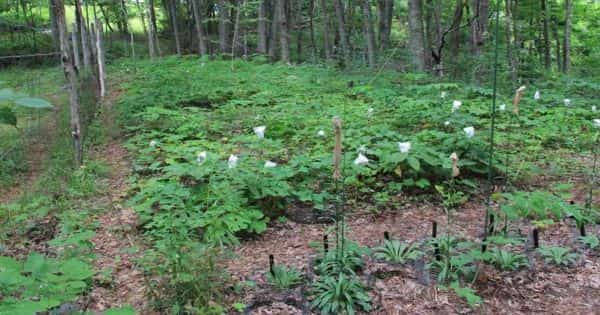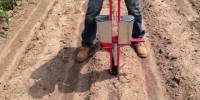Forest farming is the cultivation of high-value crops under the protection of a managed tree canopy. It is the cultivation of high-value specialty crops under a forest canopy that is intentionally modified or maintained to provide shade levels and habitat that favor growth and enhance production levels. The intensity of this farming production can vary depending on the producer’s goals, available markets, processing equipment, and the site. It is most often used on private lands to supplement the family income.
Forest farming can provide profitable opportunities for forest and woodland owners, nut growers, sugar maple growers, and herb growers.
Forest farming encompasses a range of cultivated systems from introducing plants into the understory of a timber stand to modifying forest stands to enhance the marketability and sustainable production of existing plants. Some examples of management activities include harvesting and scattering local seed; thinning out competing plants; additional site preparation for planting seeds, bulbs or plant starts; soil amendments for pH or fertility; constructed raised planting beds; pest control; and even fencing to keep out animals and poachers.
Forest farming is a type of agroforestry practice characterized by the “four I’s”: intentional, integrated, intensive, and interactive. It is the intentional cultivation of edible, medicinal, or decorative specialty crops beneath native or planted woodlands that are managed for both wood and understory crop production. Agroforestry is a land management system that combines trees with crops or livestock, or both, on the same piece of land. It does not include the gathering of naturally-occurring plants from native forests, also known as wildcrafting. It focuses on increasing benefits to the landowner as well as maintaining forest integrity and environmental health. The practice involves cultivating non-timber forest products or niche crops, some of which, such as ginseng or shiitake mushrooms, can have high market value. This farming can provide profitable opportunities for forest and woodland owners, nut growers, sugar maple growers, and herb growers.

Benefits:
- Cultivation of specialty crops in a forest setting provides new sources of annual or periodic income before, or instead of, timber harvests.
- A wide variety of plants can be grown in a forest to produce natural or processed edible, herbal, medicinal, decorative, and craft products.
- The intensively-managed cultivation of forest plants that are endangered in the wild due to over-harvesting is the responsible alternative to wildcrafting.
The forest farming community shares information about growing and selling high-value non-timber forest products. Non-timber forest products (NTFPs) are plants, parts of plants, fungi, and other biological materials harvested from within and on the edges of natural, manipulated, or disturbed forests. Non-timber forest products are a key part of the US forest-based economy. Examples of crops are ginseng, shiitake mushrooms, decorative ferns, and pine straw. Several non-timber forest products, including mushrooms and edible and shade-tolerant plants, can be intentionally cultivated or promoted to reproduce in forests using specific management practices. Products typically fit into the following categories: edible, medicinal and dietary supplements, floral or decorative, or specialty wood-based products.
















